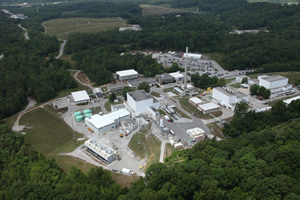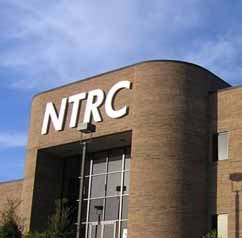Learn More
Energy Science
Buildings Technologies Research Integration Center (BTRIC)
 Building Technologies Research and Integration Center (BTRIC), in the Energy & Transportation Science Division (ETSD), focuses on research, development, and deployment of energy efficient technologies in support of the U.S. Department of Energy’s (DOE’s) goal of zero energy homes by 2020 and zero energy commercial buildings by 2025. BTRIC areas of focus are new building technologies, whole-building and community integration, and improved energy management in buildings and industrial facilities during their operational phase. A full-time staff of approximately 50 researchers conduct experiments in a DOE-designated National User Facility at Oak Ridge National Laboratory for the DOE and other sponsors, in collaboration with industry, universities, associations, and utilities.
Building Technologies Research and Integration Center (BTRIC), in the Energy & Transportation Science Division (ETSD), focuses on research, development, and deployment of energy efficient technologies in support of the U.S. Department of Energy’s (DOE’s) goal of zero energy homes by 2020 and zero energy commercial buildings by 2025. BTRIC areas of focus are new building technologies, whole-building and community integration, and improved energy management in buildings and industrial facilities during their operational phase. A full-time staff of approximately 50 researchers conduct experiments in a DOE-designated National User Facility at Oak Ridge National Laboratory for the DOE and other sponsors, in collaboration with industry, universities, associations, and utilities.
Center for Nanophase Materials Sciences (CNMS)
 The Center for Nanophase Materials Sciences at Oak Ridge National Laboratory is a collaborative nanoscience user research facility for the synthesis, characterization, theory/ modeling/ simulation, and design of nanoscale materials. It is one of five Nanoscale Science Research Centers currently being established by the Office of Science, U.S. Department of Energy.
The Center for Nanophase Materials Sciences at Oak Ridge National Laboratory is a collaborative nanoscience user research facility for the synthesis, characterization, theory/ modeling/ simulation, and design of nanoscale materials. It is one of five Nanoscale Science Research Centers currently being established by the Office of Science, U.S. Department of Energy.
High Flux Isotope Reactor (HFIR)
 Operating at 85 MW, HFIR provides one of the highest continuous fluxes of neutrons of any research reactor in the world, and its cold source is the brightest in the world. The neutron scattering research facilities at HFIR contain 15 world-class instruments either in operation or planned, including two cold source instruments. The thermal and cold neutrons produced by HFIR allow scientists to study the molecular and magnetic structures and behavior of a variety of materials, including high-temperature superconductors, polymers, metals, and biological samples. These studies are leading to scientific and technical advances in a wide range of fields, such as physics, chemistry, materials science, engineering, and biology. The reactor is also used for isotope production, materials irradiation, and neutron activation analysis.
Operating at 85 MW, HFIR provides one of the highest continuous fluxes of neutrons of any research reactor in the world, and its cold source is the brightest in the world. The neutron scattering research facilities at HFIR contain 15 world-class instruments either in operation or planned, including two cold source instruments. The thermal and cold neutrons produced by HFIR allow scientists to study the molecular and magnetic structures and behavior of a variety of materials, including high-temperature superconductors, polymers, metals, and biological samples. These studies are leading to scientific and technical advances in a wide range of fields, such as physics, chemistry, materials science, engineering, and biology. The reactor is also used for isotope production, materials irradiation, and neutron activation analysis.
National Transportation Research Center (NTRC)
 Located a few miles down the road from Oak Ridge National Laboratory are several highly-sophisticated, experimental ORNL research laboratories that constitute the Department of Energy’s (DOE) National Transportation Research Center User Facility (NTRC). As a User Facility, NTRC offers industry, academia, and other agencies the opportunity to access state-of-the-art technologies, equipment and instrumentation, and computational resources to advance transportation technologies. Research areas include transportation fuel properties and effects; engine technologies and control systems; emission control devices; power electronics; electric machines; geographic information systems; data analysis and visualization; modeling; and packaging for hazardous materials transport. These resources are critical to efforts to improve fuel economy, reduce emissions, and address transportation systems issues such as traffic congestion, evacuation planning, and highway safety.
Located a few miles down the road from Oak Ridge National Laboratory are several highly-sophisticated, experimental ORNL research laboratories that constitute the Department of Energy’s (DOE) National Transportation Research Center User Facility (NTRC). As a User Facility, NTRC offers industry, academia, and other agencies the opportunity to access state-of-the-art technologies, equipment and instrumentation, and computational resources to advance transportation technologies. Research areas include transportation fuel properties and effects; engine technologies and control systems; emission control devices; power electronics; electric machines; geographic information systems; data analysis and visualization; modeling; and packaging for hazardous materials transport. These resources are critical to efforts to improve fuel economy, reduce emissions, and address transportation systems issues such as traffic congestion, evacuation planning, and highway safety.
Shared Research Equipment (ShaRE)
 The Shared Research Equipment (ShaRE) User Facility at the Oak Ridge National Laboratory (ORNL) is one of three Electron Beam Microcharacterization Centers supported by the Scientific User Facilities Division of the Office of Science, U.S. Department of Energy. The ShaRE User Facility provides access to advanced electron microscopy and atom probe tomography capabilities.
The Shared Research Equipment (ShaRE) User Facility at the Oak Ridge National Laboratory (ORNL) is one of three Electron Beam Microcharacterization Centers supported by the Scientific User Facilities Division of the Office of Science, U.S. Department of Energy. The ShaRE User Facility provides access to advanced electron microscopy and atom probe tomography capabilities.
Spallation Neutron Source (SNS)
 SNS is an accelerator-based neutron source that provides the most intense pulsed neutron beams in the world for scientific research and industrial development. SNS is a versatile scientific tool that gives researchers more detailed snapshots of the smallest samples of physical and biological materials than ever before possible. With the suite of eventually 25 best-in-class instruments, scientists can count scattered neutrons, measure their energies and angles at which they scatter, and map their final positions. SNS allows measurements of greater sensitivity, higher speed, higher resolution, and in more complex sample environments than ever before. The diverse applications of neutron scattering research are providing opportunities for research on the structure and dynamics of materials in practically every scientific and technical field.
SNS is an accelerator-based neutron source that provides the most intense pulsed neutron beams in the world for scientific research and industrial development. SNS is a versatile scientific tool that gives researchers more detailed snapshots of the smallest samples of physical and biological materials than ever before possible. With the suite of eventually 25 best-in-class instruments, scientists can count scattered neutrons, measure their energies and angles at which they scatter, and map their final positions. SNS allows measurements of greater sensitivity, higher speed, higher resolution, and in more complex sample environments than ever before. The diverse applications of neutron scattering research are providing opportunities for research on the structure and dynamics of materials in practically every scientific and technical field.

